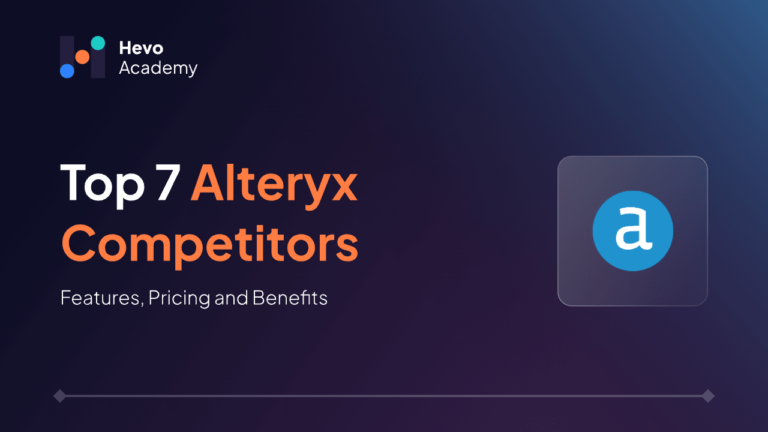When it comes to handling data—whether you’re analyzing trends, cleaning up messy spreadsheets, or automating workflows—having the right tools makes all the difference. Alteryx is a popular choice for many data teams because of its powerful features and ease of use, but it’s not the only option out there.
Table of Contents
Depending on your budget, your technical skills, and particular requirements, there are different Alteryx Competitors that could better meet the needs of your business. While others specialize in simplicity through no-code use cases, some focus on offering complex functionality to accommodate users who know how to dig their teeth into technology; few will try to bridge that gap between both of those approaches.
Alteryx is great but can be really expensive, especially for small teams or businesses. It also struggles with super large datasets and isn’t always the best fit if you’re working heavily in the cloud. Let’s get a peek at some of the best and most reliable innovation-based Alteryx Competitors and Alternatives.
What is Alteryx?
Alteryx is a data science and process automation platform and data visualization tool that enables analysts to prepare, analyze, and visualize their data within one intuitive experience. Therefore, it has been used from ETL procedures up to in-depth analytics preparation of the data. Some of the key capabilities of this software are that it offers:
- Drag-and-drop interface: Enables users to devise workflows in processing data even with no in-depth necessary level of coding.
- Data Integration: It connects to a variety of data sources like databases, APIs, cloud platforms, flat files, among others, such as Excel.
- Data Transformation: Easily filter, join, aggregate, or clean data with minimal effort.
- Advanced Analytics: It includes predictive analytics, machine learning, and spatial analysis capabilities.
- Automation: Workflows can be scheduled or automated for repetitive tasks.
Read about data analytics vs data visualisation in depth.
What are the drawbacks of using Alteryx?
The downsides of Alteryx are as follows:
- High Cost: Many times more expensive to license than open-source options, such as Python or Airflow.
- Scalability Limits: The solution cannot handle very big, complex datasets or heavy enterprise volumes.
- Coding Restrictions: Less flexible for advanced coding tasks.
- Vendor Lock-In: Workflows are proprietary and hard to migrate.
- Real-Time Limitations: Focuses on batch processing, not real-time workflows.
- Resource-Intensive: Relies on in-memory processing, requiring strong hardware.
Great for ease of use, it might feel constricting or costly for heavy-duty or complex needs. So, let’s look at its top alternatives.
Top 7 Alteryx Competitors
Below are some of the top competitors to Alteryx, offering robust alternatives for data preparation and analytics:
1. Salesforce-Tableau
Salesforce Tableau is one of the biggest players in visual analytics and business intelligence; it primarily focuses on an interactive dashboard and report-based product.
Advantages
- Intuitive drag-and-drop interface for visualization.
- Integration with Salesforce for CRM analytics.
- The Pre-built connector library is virtually large; these are used for connecting several data sources.
Use Case
Recommended for teams dealing with visualization and storytelling, utilizing their data.
Pricing
Salesforce offers pricing options to help you choose the right analytics solution for your business.
How It Compares To Alteryx
Tableau is strong in visualization whereas Alteryx has strength areas in data preparation and advanced analytics. So, there could be some complementing but this suits two different stages of the pipeline.
2. Microsoft Power BI
Microsoft Power BI is a very powerful business intelligence tool from the Microsoft stable. It has really good reporting and visualization capabilities.
Advantages
- It seamlessly integrates with all the other Microsoft products such as Excel and Azure.
- The price structure is quite affordable.
- AI-based analytics and natural language queries.
Use Case
Suitable for organizations already using Microsoft tools and looking for cost-effective visualization and analytics.
Pricing
Starting at $10/user/month for the Power BI Pro plan. Check out the Power BI pricing page for more information.
How It Stacks Up to Alteryx
Power BI is visualization-centric, whereas Alteryx offers more comprehensive data preparation and workflow automation capabilities.
3. Qlik
Qlik focuses primarily on data visualization, analytics, and self-service BI, and it comes with a suite of products, including Qlik Sense and QlikView.
Advantages
- Associative engine that makes discovery into data faster and more intuitive
- Robust in offering embedded analytics
- Hybrid, deployed both in the cloud or on-premise
Use Case
Ideal for organizations aiming to have interactive, live dashboards and analytics
Pricing
Pricing starts at $825 per month, catering upto 25 GB and 20 full users billed annually.
How it Compares to Alteryx:
Qlik concentrates more on self-service analytics and visualization, while Alteryx offers more advanced data preparation and modeling capabilities.
4. IBM
IBM analytics suite, including IBM Cognos Analytics and Watson, provides AI-enabled insights, data preparation, and enterprise-grade analytics.
Advantages
- Deep AI and machine learning capabilities
- Enterprise-scale scalability and security
- Integrates with the cloud and legacy systems within IBM
Use Case
For large enterprises that have high demands for AI-powered insights and robust data governance
Pricing
IBM Pricing Plan offers a standard plan for $10.60/user/month for IBM Cognos Analytics.
How It Stacks Up Against Alteryx
IBM offers more comprehensive AI features and enterprise-level deployments compared to Alteryx, which is geared more toward data analysis by business users and analytics experts.
5. SAP
SAP Analytics Cloud is a cloud-first end-to-end platform that has integrated BI, predictive analytics, and planning in the same environment.
Advantages
- Tight integration to the SAP ERP systems.
- Real-time analytics and predictive analytics.
- Enterprise reporting
Use Case
Best suited for organizations already leveraging SAP’s ecosystem.
Pricing
SAP has various pricing plans and features, which include block, volume,tired, and percentage pricing.
How It Compares to Alteryx:
SAP focuses on enterprise planning and forecasting, whereas Alteryx specializes in data preparation and advanced analytics workflows.
6. Informatica
Informatica is a leader in enterprise data integration, offering solutions for ETL, data quality, and master data management.
Advantages
- Features available for data quality management.
- Supports real-time and batch processing.
- Offers a robust workflow management engine.
- Allows for parallel processing, data partitioning, and pushdown optimization
Use Case
Best for large-scale enterprise data integration projects with complex data governance needs.
Pricing
Informatica’s pricing has to do with actual usage and organizational needs. Informatica Pricing Units(IPUs) give customers access to all eligible cloud services listed in the Cloud and Product Description Schedule.
How It Compares to Alteryx:
Informatica is stronger in large-scale data integration and governance, but Alteryx is best for ease of use and analytics-focused workflows.
7. MicroStrategy
MicroStrategy is a business intelligence platform that stands out for its powerful reporting and dashboarding capabilities.
Advantages
- Enterprise-grade BI with scalability.
- Strong mobile analytics support.
- Advanced security and data governance.
Use Case
Suitable for enterprises with the need to deploy large-scale, secure BI.
Pricing
You can request a price quote from an expert by signing in or creating an account on the MicroStrategy website.
How It Compares to Alteryx
MicroStrategy focuses on visualization and reporting, whereas Alteryx’s strengths are in data preparation and automation.
Conclusion
At the end of the day, the right tool for your data work depends on what you need and how you work. While Alteryx is a solid choice for many, there are plenty of great alternatives out there that might be a better fit for your team, your budget, or your specific challenges.
Whatever your requirements—simple, powerful, or somewhere in between—you are bound to find the right tool for the job. And if you take the time to explore your options, you will surely find one that makes your work easier, faster, and maybe even a little more fun.
Hevo’s near real-time data movement platform simplifies data integration challenges in any data analytics project. Want to give Hevo a try? Sign Up for a 14-day free trial and experience the feature-rich Hevo suite firsthand.
FAQs
1. What are the drawbacks of Alteryx?
Alteryx can be expensive, has a learning curve, and may struggle with large datasets, especially when dealing with complex workflows.
2. Is Snowflake similar to Alteryx?
No, Snowflake is a cloud-based data warehousing platform for scalable storage and querying, while Alteryx focuses on simplifying data analytics and ETL processes. However, they can complement each other in a data pipeline.
3. What is the competitive advantage of Alteryx?
Alteryx stands out for its intuitive drag-and-drop interface, strong automation capabilities, and integration with various data sources, making it user-friendly for data analysts and business users.


